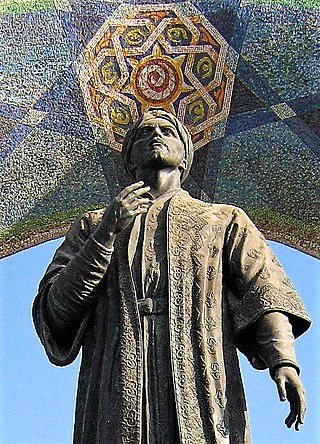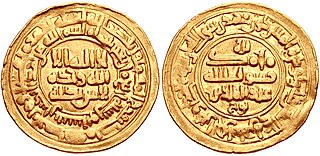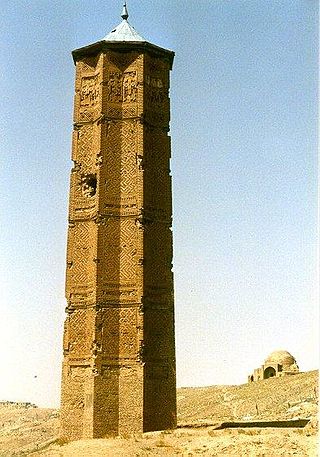
The Tahirid dynasty was an Arabized Sunni Muslim dynasty of Persian dehqan origin that ruled as governors of Khorasan from 821 to 873 as well as serving as military and security commanders in Abbasid Baghdad until 891. The dynasty was founded by Tahir ibn Husayn, a leading general in the service of the Abbasid caliph al-Ma'mun. For his support of al-Ma'mun in the Fourth Fitna, he was granted the governance of Khorasan.

Rudaki was a poet, singer, and musician who is regarded as the first major poet to write in New Persian. A court poet under the Samanids, he reportedly composed more than 180,000 verses, yet only a small portion of his work has survived, most notably a small part of his versification of the Kalila wa-Dimna, a collection of Indian fables.

Abd al-Malik I was amir of the Samanid Empire from 954 to 961. He was the son and successor of Nuh I. His reign was marked by internal strife, with the Turkic slave-soldiers increasing in power. He died after falling from his horse during a game of polo at Bukhara. He was succeeded by his brother Mansur I, who was put on the throne by a faction of ghulams led by the Turkic slave-commander, Fa'iq Khassa.

Abu Salih Mansur, better known as Mansur I (منصور) was amir of the Samanids from 961 to 976. The son of Nuh I, his reign was characterized by weak rule and perpetual financial troubles. Mansur was notably the first Samanid ruler to the use title of King of Kings (Shahanshah), most likely as a response to his rival, the Buyid ruler Adud al-Dawla, who likewise used the title. He is also known by the sobriquet Amīr-i Sadid.

The House of Karen, also known as Karen-Pahlav, was one of the Seven Great Houses of Iran during the rule of Parthian and Sassanian Empires. The seat of the dynasty was at Nahavand, about 65 km south of Ecbatana. Members of House of Karen were of notable rank in the administrative structure of the Sassanian empire in multiple periods of its four century-long history.
Abu Ali Muhammad Bal'ami, also called Amirak Bal'ami and Bal'ami-i Kuchak, was a 10th-century Persian historian, writer, and vizier to the Samanids. He was from the influential Bal'ami family.
Abuʾl-Ḥasan al-Qāsim Aḥmad ibn Ḥasan Maymandī was a Persian vizier of the Ghaznavid ruler Mahmud of Ghazni and the latter's son Mas'ud I of Ghazni.
Sharwin II, was the tenth ruler of the Bavand dynasty from 896 to 930.
Abu'l-Fadl al-Bal'ami, also known as Bal'ami the Elder, was a Samanid statesman from the al-Bal'ami family, who served as the vizier of Nasr II from 922 to 938.
Rustam II, was the twelfth ruler of the Bavand dynasty from 964 to 979. He was the brother and successor of Shahriyar II.
This is a family tree of the Bavandid rulers, and their ancestors.
Abu Mansur Muhammad ibn 'Abd al-Razzaq ibn 'Abdallah ibn Farrukh, also simply known as Abu Mansur Muhammad and Ibn 'Abd al-Razzaq, was an Iranian aristocrat who served the Samanids during the most of career, and briefly served as governor of Azerbaijan under the Buyids.
Abu'l-Husain Abd-Allah ibn Ahmad Utbi, better known as Abu'l-Husain Utbi, was an Iranian statesman from the Utbi family, who served as the vizier of the Samanid ruler Nuh II from 977 to 982.
Ibrahim ibn Simjur was a Samanid military officer from the Simjurid family.
Böritigin or Böri, also known as Pirai, was a Turkic officer, who served as the Samanid governor of Ghazna from 974/975 to 977.
Abu Ishaq Ibrahim, also known as Ishaq ibn Alp-Tegin, was a Turkic officer, who was the Samanid governor of Ghazna from September 963 to November 966. He was the son and successor of Alp-Tegin.
Abu Bakr Lawik was a ruler of Ghazna from the Lawik dynasty. He was most likely a vassal of the Samanid Empire. In 962, the Turkic slave commander Alp-Tegin captured Ghazna after besieging the Citadel of Ghazni for four months. However, a few years later, Lawik managed to re-capture the town from Abu Ishaq Ibrahim, the son and successor of Alp-Tegin. This was not to last long; Abu Ishaq Ibrahim shortly returned to the town with Samanid aid, and took control of the town once again. Abu Bakr Lawik is thereafter no longer mentioned; he died before 977, the year that Ghaznavid control was established in Ghazna.

Ghazni is a city in southeastern Afghanistan, which served as the capital of the Ghaznavid Empire from 977 to 1163.
Asfar ibn Shiruya was an Iranian military leader of Gilaki origin, active in northern Iran in the early 10th century. He played a major role in the succession disputes of the Alids of Tabaristan, and managed to establish himself as the ruler of Tabaristan and northern Jibal briefly from 928 to 930.





